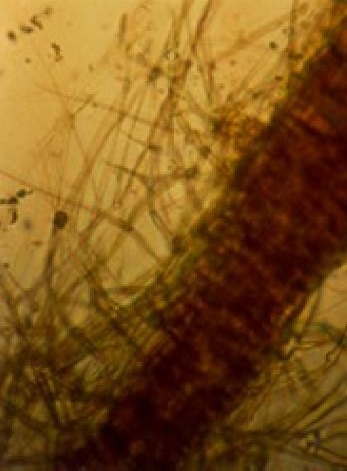The strands colonize the root.
Cotton root rot fungal spore mat.
In this photo we wanted to show you what the sporemats of cotton root rot looks like when they emerge on the soil or tree surface.
Alkaline soils soils low in organic matter.
Spore mats and conidia.
A unique feature of this disease is the production of spore mats that may form on the soil surface near dead.
Sclerotia germinate and produce strands that grow through soil and eventually contact roots.
Cotton root rot also known as texas root rot and by its scientific name phymatotricum root rot is caused by the the soil borne fungus phymatotrichum omnivorum and is responsbile for serious and usually fatal root rots on more than 2 300 species of plants.
The fungus attacks more than 2 000 species of broadleaf plants but does not affect monocots grasses.
It is one of the most destructive plant diseases and attacks more than 2 000 species.
Fresh spore mat of cotton root rot fungus.
Phymatotrichum root rot also known as cotton root rot and texas root rot is caused by the fungus phymatotrichopsis ominvorum.
Factors affecting the disease and fungal survival this fungus can survive many years in soil as sclerotia which can occur at depths of 7 feet.
Cotton root rot typically occurs in specific geographies in the southwestern united states and is found in arizona california texas new mexico and oklahoma cotton root rot is prevalent in calcareous alkaline.
The disease has afflicted the cotton industry for more than 100 years.
Cotton root rot caused by the fungus phymatotrichum omnivorum also is known by several other names such as phymatotrichum root rot texas root rot and ozonium root rot.
Cotton root rot fungal mats.
Fungal threads on roots spore mats around infected plants.
Cotton root rot has been reported in texas counties from the red river to the rio grande and from tom green county to the neches river.
These mats vary in size from 2 to 16 inches in diameter and are white to tan colored.
Factors affecting the disease and fungal survival this fungus can survive many years in soil as sclerotia which can occur at depths of 7 feet.
If you see this fungus on the soil or your tree there s a problem.
Avoid infested locations plant non hosts or resistant species.
Phymatotrichum root rot also known as cotton root rot or texas root rot is caused by the soil borne fungus.
Survival structures produced in soil away from the host roots.
Cotton root rot is a soilborne disease caused by the fungi phymatotrichum omnivorum cotton texas root rot.

